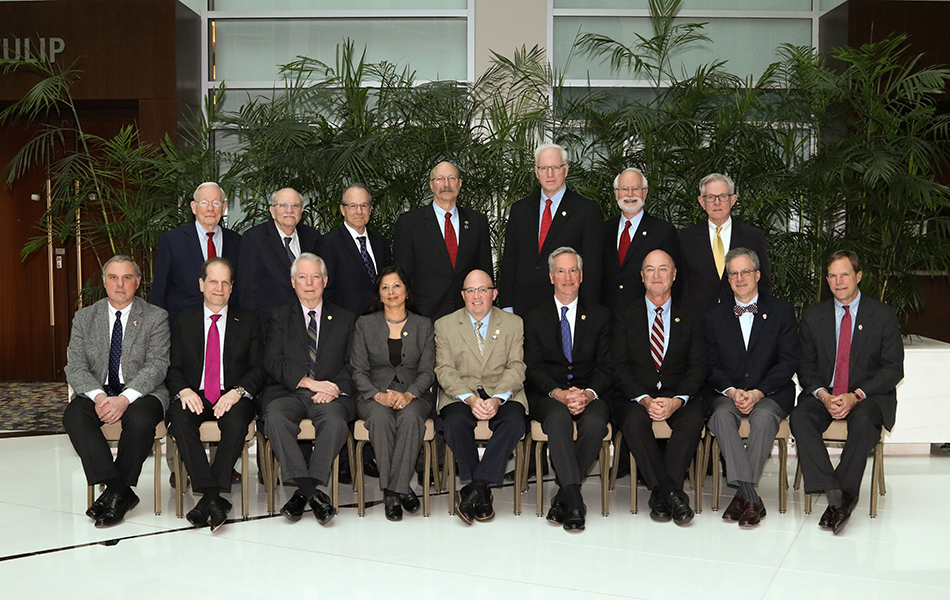The Evolution of the ACC Board of Governors and State Chapters: Leadership Development for ACC's Leaders of Tomorrow
Since its founding, the ACC has been focused on the future – for both its members and the patients they serve. One of the best examples of this focus is the role of ACC’s Chapter system and the College’s Board of Governors (BOG) in the development of ACC’s leaders of tomorrow. Additionally, the College has harnessed the expertise of its Chapters and BOG leaders in the development and rollout of its current Strategic Plan, as well as implementation of many programs and initiatives that support the mission to transform cardiovascular care and improve heart health. BOG and Chapter input will continue to be critical as the ACC develops its next Strategic Plan for 2019 – 2023.
To better understand the place Chapters and BOG have within ACC, we must look at their origins and history. The BOG was first established in 1951 when the College chartered 22 state chapters to give added voice to the membership. The charge of the BOG was to “determine the policies, activities and scope of the College, and receive at the annual meeting reports from the Board of Trustees (BOT), officers and committee [chairs] concerning their activities.” The first meeting of the BOG was held during ACC’s annual scientific session in June 1952 in New York City.
"ACC leaders have risen through the ranks of ACC’s state chapters to ultimately serve as governors, standing committee chairs, trustees, officers and presidents at the national level. In fact, 50 of the ACC Presidents have served as ACC Governor and/or BOG Chair."
The BOG structure changed in the fall of 1954 when, under the leadership of then ACC President Ashton Graybiel, MD, MACC, the BOT voted to eliminate ACC State Chapters as well as the BOG. Graybiel believed that the ACC would be better served if it consisted of a single national organization that was not constrained by the more localized needs of state chapters. The BOG remained dormant until 1957 when the BOT recommended reactivation. The sole function of the “new” BOG was to review and pass on the qualifications of candidates for membership in ACC. The BOT appointed 35 U.S. and three Canadian governors in February 1957. The BOG expanded as the membership grew, and came into its current number of over 60 members in the mid-1960s. In 1966, the ACC began allowing members to elect their local governor.
During the mid-1980s, the ACC began to expand its focus on the socioeconomic aspects of cardiology practice in response to issues of cost, access and quality of care. Today’s state chapter structure can be traced to this period. The main incentive to create ACC state chapters was to help cardiovascular specialists respond in a coordinated way to the growing number of local and regional challenges they faced in the areas of legislation, regulation and reimbursement. Florida became the first “new” state chapter in 1986, with other states following in rapid succession.
Today, the focus of the BOG has broadened from membership and credentialing issues to include state health care advocacy and to serve as the ACC’s “eyes and ears on the ground.” ACC’s domestic Chapters now serve as the voice of the cardiovascular community at the local level, promoting quality care initiatives, supporting educational programs and helping to influence state legislative and regulatory efforts affecting the practice of cardiovascular medicine.
Additionally, Chapter Governors remain the only elected leaders in the College and now represent 48 state chapters encompassing all 50 states, plus Puerto Rico, Canada, Mexico and U.S. Armed Services, the Veterans Administration and the U.S. Public Health Service. Governors also serve as chapter presidents in the states and regions where chapters exist. The BOG has continued to grow and mature as a leadership body. With its pivotal role in the College’s Strategic Plan, and the acknowledgement of the importance of communication between ACC and its members, the BOG has become a vital constituency upon which the College relies for information, communication, vision setting and rekindling many of the responsibilities and expectations it had during its first incarnation in 1952.
Engagement in ACC Chapters provides members with a variety of opportunities to meet their colleagues from communities or hospitals in their state or region. Annual chapter meetings cover the spectrum from traditional continuing medical education programs to presentations devoted exclusively to state advocacy issues with special opportunities for Fellows in Training to get involved with College activities. Chapters are also where many ACC leaders get their start. ACC leaders have risen through the ranks of ACC’s state chapters to ultimately serve as governors, standing committee chairs, trustees, officers and presidents at the national level. In fact, 50 of the ACC Presidents have served as ACC Governor and/or BOG Chair.
Many of the challenges affecting the College and its members today are remarkably like those faced since the ACC’s founding in 1949. The BOG and state chapters embracing previous successes and learning from those who came before will ensure the College continues to grow and serve as the primary professional home for the entire cardiovascular community.
 ACC's current Board of Governors.
ACC's current Board of Governors.
 ACC Past Chairs Breakfast at ACC.17 in Washington, DC.
ACC Past Chairs Breakfast at ACC.17 in Washington, DC.
Learn more about ACC Chapters at ACC.org/Chapters. For more on ACC’s International Chapters, go to ACC.org/International.
 Read the full May 2017 issue of Cardiology at ACC.org/Cardiology Read the full May 2017 issue of Cardiology at ACC.org/Cardiology |
Keywords: ACC Publications, Cardiology Magazine, ACC History, Credentialing, Education, Medical, Continuing, Leadership, Learning, Policy, Quality of Health Care, Specialization, Trustees, United States Department of Veterans Affairs, United States Public Health Service
< Back to Listings
